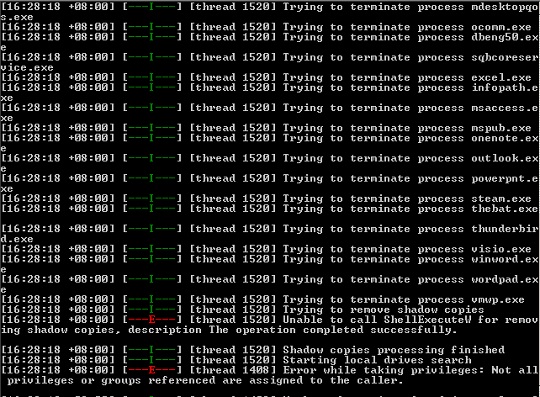Ransom.Win32.MONEYMESS.THCCOBC
UDS:Trojan-Ransom.Win32.MoneyMessage.a (KASPERSKY)
Windows


Threat Type: Ransomware
Destructiveness: No
Encrypted:
In the wild: Yes
OVERVIEW
Downloaded from the Internet, Dropped by other malware
This Ransomware arrives on a system as a file dropped by other malware or as a file downloaded unknowingly by users when visiting malicious sites.
TECHNICAL DETAILS
737,644 bytes
EXE
No
30 Mar 2023
Drops files, Disables AV, Terminates processes, Encrypts files
Arrival Details
This Ransomware arrives on a system as a file dropped by other malware or as a file downloaded unknowingly by users when visiting malicious sites.
Installation
This Ransomware drops the following files:
- {Drive Letter:}:\money_message.log
It adds the following processes:
- "%System%\cmd.exe" /c vssadmin.exe delete shadows /all /quiet
(Note: %System% is the Windows system folder, where it usually is C:\Windows\System32 on all Windows operating system versions.)
It leaves text files that serve as ransom notes containing the following:
- {Drive Letter:}:\money_message.log

It adds the following mutexes to ensure that only one of its copies runs at any one time:
- 12345-12345-12235-12354
Process Termination
This Ransomware terminates the following services if found on the affected system:
- vss
- sql
- svc$
- memtas
- mepocs
- sophos
- veeam
- backup
- vmms
It terminates the following processes if found running in the affected system's memory:
- sql.exe
- oracle.exe
- ocssd.exe
- dbsnmp.exe
- synctime.exe
- agntsvc.exe
- isqlplussvc.exe
- xfssvccon.exe
- mydesktopservice.exe
- ocautoupds.exe
- encsvc.exe
- firefox.exe
- tbirdconfig.exe
- mdesktopqos.exe
- ocomm.exe
- dbeng50.exe
- sqbcoreservice.exe
- excel.exe
- infopath.exe
- msaccess.exe
- mspub.exe
- onenote.exe
- outlook.exe
- powerpnt.exe
- steam.exe
- thebat.exe
- thunderbird.exe
- visio.exe
- winword.exe
- wordpad.exe
- vmwp.exe
Other Details
This Ransomware does the following:
- The following may change depending on the malware configuration:
- info_text_message → serves as ransom note
- mutex_name
- extension
- skip_directories
- network_public_key
- network_private_key
- processes_to_kill
- logging → network logging in capability
- domain_login
- domain_password
- crypt_only_these_directories
- It encrypts files found in the following drive types:
- Fixed drive
- Removable drive
- Network drive
- It displays its execution log and encryption progress in console.

- It does not append extension on encrypted files.
- It has the capability to propagate on network shares by logging in pre-defined credentials included on the malware configuration.
It does not proceed to its malicious routine if it detects that it is being debugged.
Ransomware Routine
This Ransomware avoids encrypting files with the following strings in their file name:
- desktop.ini
- ntuser.dat
- thumbs.db
- iconcache.db
- ntuser.ini
- ntldr
- bootfont.bin
- ntuser.dat.log
- bootsect.bak
- boot.ini
- autorun.inf
It avoids encrypting files found in the following folders:
- msocache
- $windows.~ws
- system volume information
- perflogs
- programdata
- program files (x86)
- program files
- $windows.~bt
- windows
- windows.old
- boot
SOLUTION
9.800
18.352.02
30 Mar 2023
18.353.00
31 Mar 2023
Step 1
Before doing any scans, Windows 7, Windows 8, Windows 8.1, and Windows 10 users must disable System Restore to allow full scanning of their computers.
Step 2
Note that not all files, folders, and registry keys and entries are installed on your computer during this malware's/spyware's/grayware's execution. This may be due to incomplete installation or other operating system conditions. If you do not find the same files/folders/registry information, please proceed to the next step.
Step 3
Search and delete this file
- {Drive Letter:}:\money_message.log
Step 4
Scan your computer with your Trend Micro product to delete files detected as Ransom.Win32.MONEYMESS.THCCOBC. If the detected files have already been cleaned, deleted, or quarantined by your Trend Micro product, no further step is required. You may opt to simply delete the quarantined files. Please check the following Trend Micro Support pages for more information:
Step 5
Restore encrypted files from backup.
Did this description help? Tell us how we did.

